Analysis: Nuummite

Greenland Nuummite and lookalikes
When you look for ‘nuummite’ online or at a mineral show, you will find stones with different appearances for very different prices. In addition to precious tumble stones and jewelry made of “genuine Greenland nuummite,” I also found stones sold for a soft price as Chinese or Indian nuummite, also known as coppernite or copperlite. Recently the names Star Galaxy Gold stone and Star Galaxy Granite also came up as commercial names for ‘Indian nuummite’. Unfortunately, I also came across expensive stones with the appearance of Chinese or Indian nuummite, but with a Greenland origin mentioned. This of course raises the question whether this is all (genuine Greenlandic) nuummite.
In this article, I describe what nuummite is, what lookalikes are on the market and how to recognize real nuummite.
What is Greenlandic nuummite?
Nuummite is an unofficial name for a dark metamorphic rock with elongated, golden to blue iridescent crystals. These crystals consist of alternating lamellae of anthophyllite and gedrite, two minerals from the ortho-amphibole group. The appearance is also sometimes described as a kind of “golden meteor shower,” the crystals usually having an orientation in a certain direction.

Example of ‘golden meteor shower’ appearance of Greenland nuummite (photo Mindat: © Kuno Stoeckli).
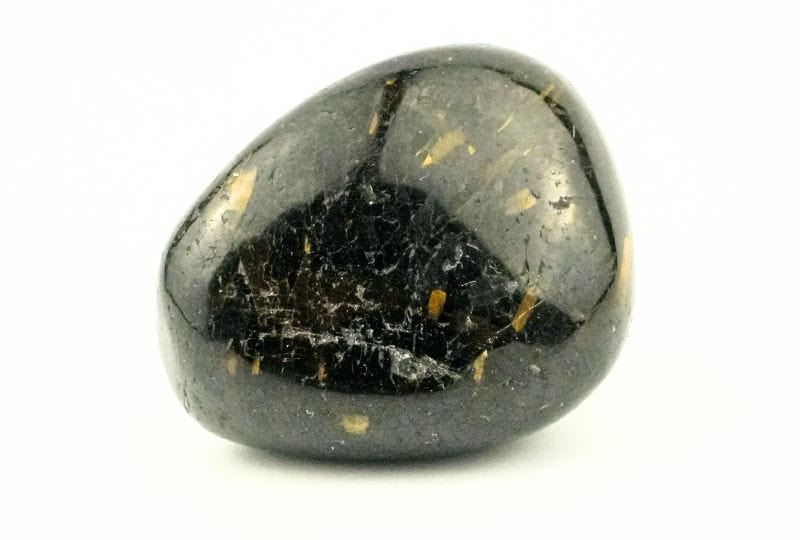

The rock was (re)discovered in 1982 by geologist Peter W. Uitterdijk Appel near Nuuk, Greenland. He called it “nuummite” which means “of Nuuk” in Greenlandic. Nuummite is found at only eight sites within a 50-km radius of Nuuk, all in ortho-amphibolite lenses in quartz gneiss. The Greenland government has granted the Nuummite Nuuk A/S company, wholly owned by the community of Nuuk, an exploration concession for nuummite in the Nuuk area, as well as permission to manufacture and sell nuummite jewelry.
Genuine nuummite from Greenland is therefore rare and precious, and as is often the case then, imitations or cheaper similar material from other deposits are sold under the same name. Unfortunately, this is also the case with nuummite.
Chinese and Indian lookalikes
The stones from China or India are very similar and also somewhat similar to the Greenland nuummite, but obviously lack the elongated golden to blue iridescent crystals. It is a dark gray to brownish-black stone with black angular crystals and crystals with a “coppery” flash. The structure is that of a magmatic rock, as there is no orientation visible in the grains as is evident in metamorphic nuummite. Greenland nuummite is strongly magnetic, these variants not to weak. Moreover, with short wave UV (SW 255 nm) the matrix turns deep red, which is not the case with Greenlandic nuummite. So on closer inspection, this is obviously a different rock, but to find out exactly what this material is, I had an analysis done in a laboratory.
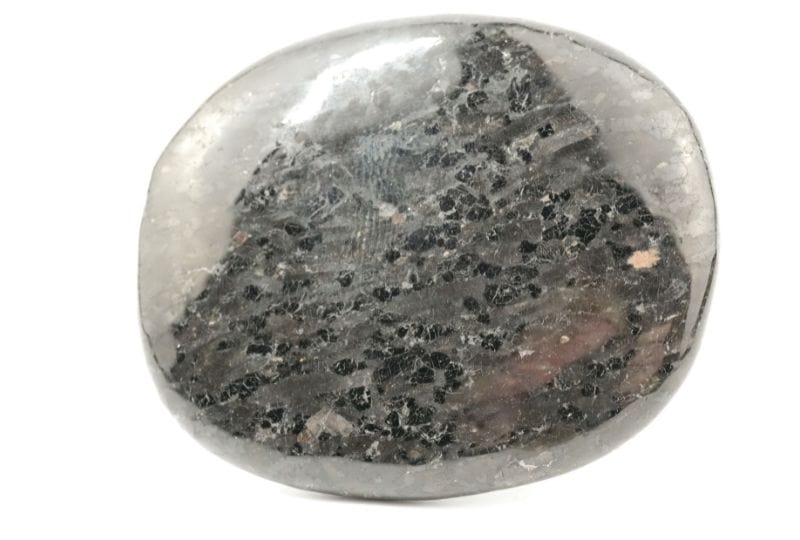


By means of EDX and Raman spectroscopy and X-ray diffraction (XRD) it has been determined that the gray-brown matrix consists of the minerals anorthite and albite (both a kind of plagioclase feldspar) and the black crystals of enstatite (a mineral from the pyroxene group). So a totally different composition than real Greenlandic nuummite and it is indeed a Chinese or Indian nuummite lookalike. Although there are important differences in appearance.
Based on the mineral content and texture, it is a gabbro rock. Based on that, I did another search in the natural stone industry standard and found a gabbro rock from Ongole, India that is nearly identical to this Chinese/Indian nuummite, with the same coppery flash in the enstatite crystals. Marketed in the natural stone trade under the trade name Star Galaxy (Gold). Perhaps someone has thought of selling tumble stones, jewelry and figures from it in addition to tiles and countertops.
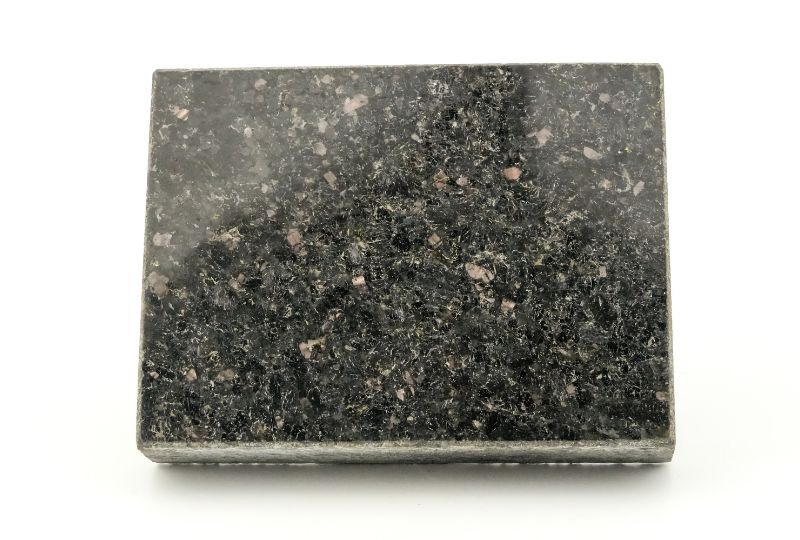
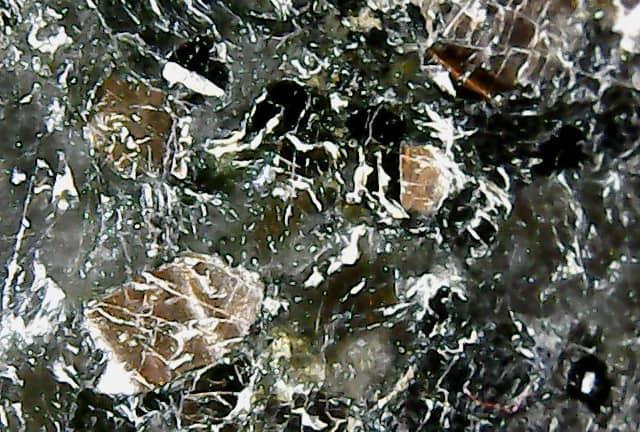
It is not unlikely that the Dutch sellers who now use the name Star Galaxy Gold / Granite for the lookalikes have taken this from the earlier analysis on this website or my book “Belazeriet of niet?”. That would be nice, of course, and using that name is also understandable and in line with naming in the natural stone trade. It is also more correct than ‘nuummite’. But unfortunately, in addition, the designation ‘Indian nuummite’ is still used as a synonym by many sellers and that is misleading, as the composition and properties are completely different from nuummite.
So what should we call these lookalikes in commerce? While I obviously favor pure geological naming, I understand that a catchy commercial name has more support. Gabbro, consisting of anorthite, albite and enstatite does not sound sexy and no one searches for it. If the description explains the minerals it contains well, Star Galaxy (Gold) stone seems to me a fine commercial name, without the use of the designation ‘nuummite’ and with the correct origin of course.
Nuummite from Finland?
As I described above, the name nuummite was given to a specific rock originating in Greenland. However, several places mentioned nuummite from Finland and in 2023 I bought a piece of it to study more closely. Would this be real nuummite or is this also a lookalike?
This was a rough piece of dark gray-green rock consisting of various minerals, mainly thin elongated crystals in fan shape. Based on the stated origin from Finland and the external characteristics (especially the lack of elongated gold/blue iridescent crystals), it was suspected that this was not nuummite. Of course, it is possible that a rock with similar composition and appearance to Greenlandic nuummite could be found outside Greenland, but after the experience with the Chinese and Indian lookalike, I was skeptical.


The website Mindat.org does list one location for nuummite in Finland, namely Kainuanmäki, Paltamo, Kainuu, Finland. Unfortunately, no photos of the material from this location are available on Mindat. In the online book ‘Gemstones of Finland’ (Geological Survey of Finland, 2017) Finnish nuummite is described in detail and this does include images. Both appearance and composition match the Greenland nuummite, so there may well be similar rocks from Finland! But my piece does not resemble the images of Finnish nuummite at all, so time to study its properties more closely.


Thus, the appearance of the analyzed rough rock does not match nuummite from Greenland or Finland, but it is possible that iridescent crystals may become visible after polishing. The crystal shape, perfect cleavage and hardness (5-6) of the fan-shaped prisms do match amphiboles as found in nuummite, but based on my own observations and measurements, I could not give a definitive answer about the exact composition of the stone. What did stand out was the difference in magnetism: the Greenland nuummite is strongly magnetic, the Finnish stone studied is not magnetic at all. But probably the magnetism of the Greenland nuummite is caused by the presence of an ore mineral such as magnetite that may not be present in this stone from Finland.
Based on EDX analysis and Raman spectroscopy, it could be determined that the minerals in the analyzed sample belong to the group of magnesium-iron-manganese amphiboles within the amphibole supergroup, but the analysis of the composition of the rock was not conclusive. It probably consists of cummingtonite-grunerite, but additional analyses are still needed to identify the exact minerals. So while the minerals the rock is composed of do belong to the same group of amphiboles to which anthophyllite and gedrite (the constituents of nuummite) also belong, whether they are indeed the same constituents remains uncertain. At least in rough form, the appearance does not match.
So yes, there does exist a rock related to Greenland nuummite from Finland, which is also called Finnish nuummite by the Finnish Geological Survey. Unfortunately, the piece analyzed is not a convincing example of this. Nuummite is popular and precious, use of the name for this material that looks different from the Greenlandic material without conclusive evidence is confusing and not recommended. Also, since this material in rough form really does look different, the name “nuummite lookalike” or “Finnish nuummite” is not appropriate.
How can I tell if my nuummite is real?
- The main characteristic of true nuummite is its appearance with elongated golden to blue iridescent crystals in a dark gray matrix. We see this in both the nuummite from Greenland and those from Finland. The Chinese and Indian lookalikes have angular dark crystals and crystals with copper-colored “flash.
- The elongated crystals in true nuummite usually have an orientation in a certain direction. The square copper-colored crystals in the Chinese and Indian lookalike do not have this and are randomly located in the stone.
- Greenland nuummite is strongly magnetic, the Chinese and Indian lookalike not to weak.
- The Chinese and Indian lookalike reacts to short wave UV (SW UV 256 nm), the matrix of feldspar then turns deep red. Greenland nuummite does not react to UV.


A brief summary of an earlier version of this analysis (2021) is included in my book “Belazeriet of niet?”. These analyses were made possible in part by donations through GoFundMe and several vendors who provided the stones studied.
As of September 2025, this information is also available through the “Gem or Scam” library.


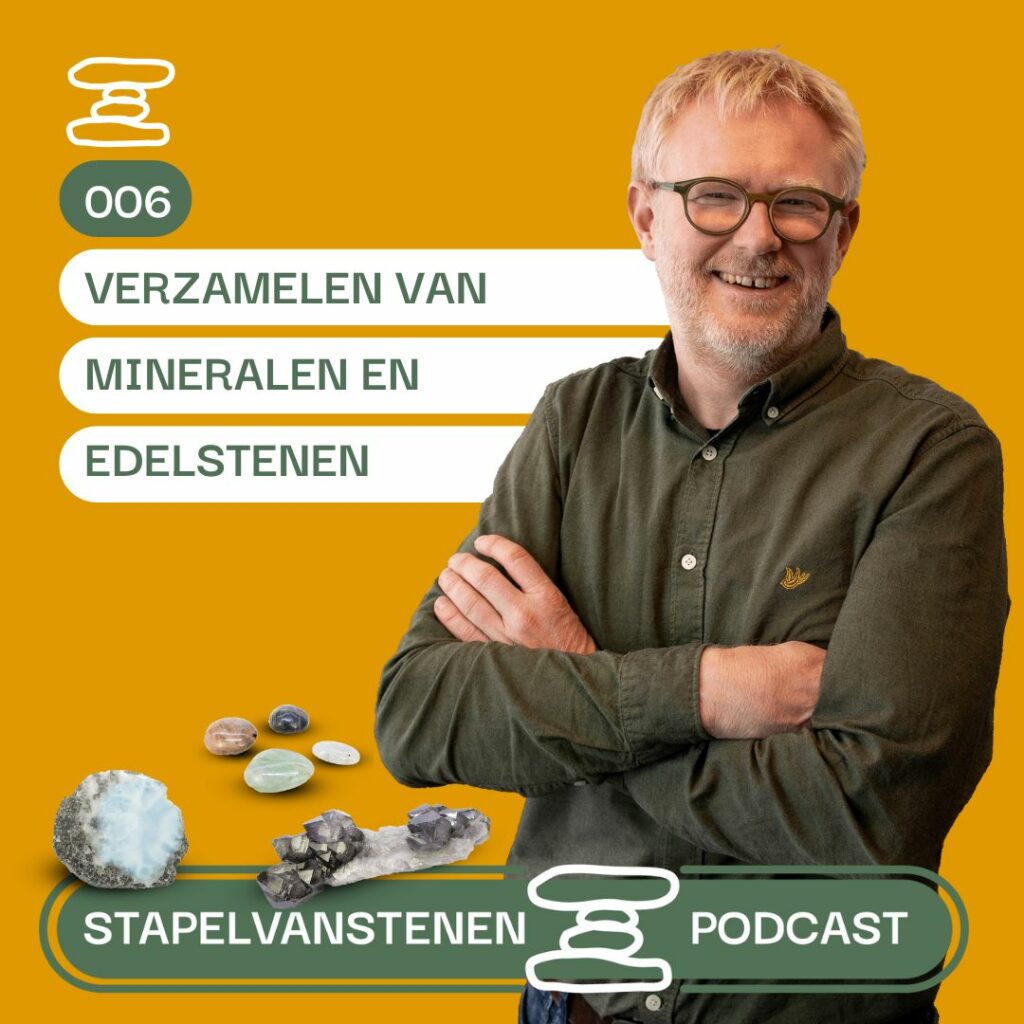

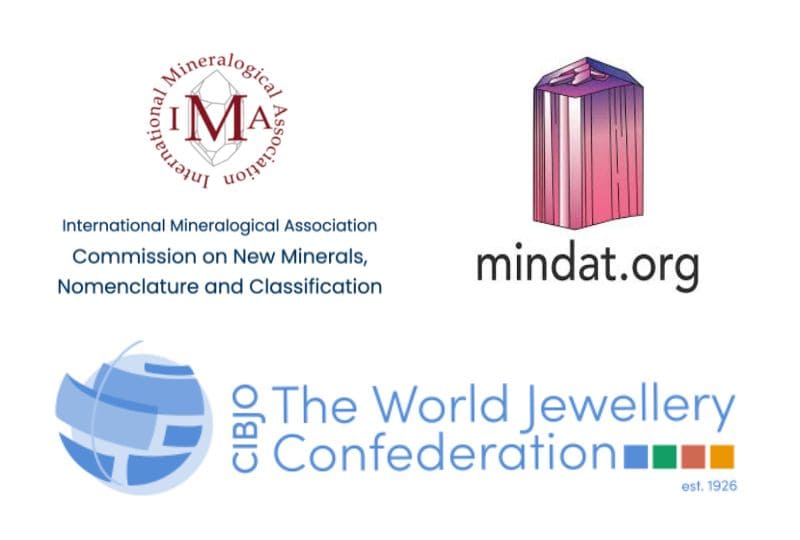
Responses